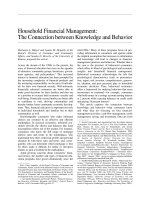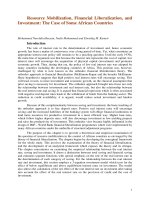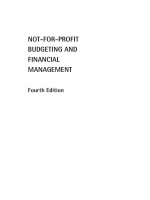Capital markets, financial management, and investment management
Bạn đang xem bản rút gọn của tài liệu. Xem và tải ngay bản đầy đủ của tài liệu tại đây (4.47 MB, 833 trang )
Finance
The Frank J. Fabozzi Series
Fixed Income Securities, Second Edition by Frank J. Fabozzi
Focus on Value: A Corporate and Investor Guide to Wealth Creation by James L. Grant and James A. Abate
Handbook of Global Fixed Income Calculations by Dragomir Krgin
Managing a Corporate Bond Portfolio by Leland E. Crabbe and Frank J. Fabozzi
Real Options and Option-Embedded Securities by William T. Moore
Capital Budgeting: Theory and Practice by Pamela P. Peterson and Frank J. Fabozzi
The Exchange-Traded Funds Manual by Gary L. Gastineau
Professional Perspectives on Fixed Income Portfolio Management, Volume 3 edited by Frank J. Fabozzi
Investing in Emerging Fixed Income Markets edited by Frank J. Fabozzi and Efstathia Pilarinu
Handbook of Alternative Assets by Mark J. P. Anson
The Global Money Markets by Frank J. Fabozzi, Steven V. Mann, and Moorad Choudhry
The Handbook of Financial Instruments edited by Frank J. Fabozzi
Interest Rate, Term Structure, and Valuation Modeling edited by Frank J. Fabozzi
Investment Performance Measurement by Bruce J. Feibel
The Handbook of Equity Style Management edited by T. Daniel Coggin and Frank J. Fabozzi
The Theory and Practice of Investment Management edited by Frank J. Fabozzi and Harry M. Markowitz
Foundations of Economic Value Added, Second Edition by James L. Grant
Financial Management and Analysis, Second Edition by Frank J. Fabozzi and Pamela P. Peterson
Measuring and Controlling Interest Rate and Credit Risk, Second Edition by Frank J. Fabozzi,
Steven V. Mann, and Moorad Choudhry
Professional Perspectives on Fixed Income Portfolio Management, Volume 4 edited by Frank J. Fabozzi
The Handbook of European Fixed Income Securities edited by Frank J. Fabozzi and Moorad Choudhry
The Handbook of European Structured Financial Products edited by Frank J. Fabozzi and Moorad Choudhry
The Mathematics of Financial Modeling and Investment Management by Sergio M. Focardi and Frank J. Fabozzi
Short Selling: Strategies, Risks, and Rewards edited by Frank J. Fabozzi
The Real Estate Investment Handbook by G. Timothy Haight and Daniel Singer
Market Neutral Strategies edited by Bruce I. Jacobs and Kenneth N. Levy
Securities Finance: Securities Lending and Repurchase Agreements edited by Frank J. Fabozzi and Steven V. Mann
Fat-Tailed and Skewed Asset Return Distributions by Svetlozar T. Rachev, Christian Menn, and Frank J. Fabozzi
Financial Modeling of the Equity Market: From CAPM to Cointegration by Frank J. Fabozzi, Sergio M.
Focardi, and Petter N. Kolm
Advanced Bond Portfolio Management: Best Practices in Modeling and Strategies edited by Frank J. Fabozzi,
Lionel Martellini, and Philippe Priaulet
Analysis of Financial Statements, Second Edition by Pamela P. Peterson and Frank J. Fabozzi
Collateralized Debt Obligations: Structures and Analysis, Second Edition by Douglas J. Lucas, Laurie S.
Goodman, and Frank J. Fabozzi
Handbook of Alternative Assets, Second Edition by Mark J. P. Anson
Introduction to Structured Finance by Frank J. Fabozzi, Henry A. Davis, and Moorad Choudhry
Financial Econometrics by Svetlozar T. Rachev, Stefan Mittnik, Frank J. Fabozzi, Sergio M. Focardi, and Teo Jasic
Developments in Collateralized Debt Obligations: New Products and Insights by Douglas J. Lucas,
Laurie S. Goodman, Frank J. Fabozzi, and Rebecca J. Manning
Robust Portfolio Optimization and Management by Frank J. Fabozzi, Peter N. Kolm,
Dessislava A. Pachamanova, and Sergio M. Focardi
Advanced Stochastic Models, Risk Assessment, and Portfolio Optimizations by Svetlozar T. Rachev,
Stogan V. Stoyanov, and Frank J. Fabozzi
How to Select Investment Managers and Evaluate Performance by G. Timothy Haight, Stephen O. Morrell,
and Glenn E. Ross
Bayesian Methods in Finance by Svetlozar T. Rachev, John S. J. Hsu, Biliana S. Bagasheva, and Frank J. Fabozzi
The Handbook of Municipal Bonds edited by Sylvan G. Feldstein and Frank J. Fabozzi
Subprime Mortgage Credit Derivatives by Laurie S. Goodman, Shumin Li, Douglas J. Lucas,
Thomas A Zimmerman, and Frank J. Fabozzi
Introduction to Securitization by Frank J. Fabozzi and Vinod Kothari
Structured Products and Related Credit Derivatives edited by Brian P. Lancaster, Glenn M. Schultz, and
Frank J. Fabozzi
Handbook of Finance: Volume I: Financial Markets and Instruments edited by Frank J. Fabozzi
Handbook of Finance: Volume II: Financial Management and Asset Management edited by Frank J. Fabozzi
Handbook of Finance: Volume III: Valuation, Financial Modeling, and Quantitative Tools edited by
Frank J. Fabozzi
Finance
Capital Markets,
Financial Management,
and Investment Management
FRANK J. FABOZZI
PAMELA PETERSON DRAKE
John Wiley & Sons, Inc.
Copyright © 2009 by John Wiley & Sons, Inc. All rights reserved.
Published by John Wiley & Sons, Inc., Hoboken, New Jersey.
Published simultaneously in Canada.
No part of this publication may be reproduced, stored in a retrieval system, or transmitted in any form or by any means, electronic, mechanical, photocopying, recording, scanning, or otherwise, except as permitted under Section 107 or 108 of the 1976 United States
Copyright Act, without either the prior written permission of the Publisher, or authorization
through payment of the appropriate per-copy fee to the Copyright Clearance Center, Inc., 222
Rosewood Drive, Danvers, MA 01923, (978) 750-8400, fax (978) 646-8600, or on the web
at www.copyright.com. Requests to the Publisher for permission should be addressed to the
Permissions Department, John Wiley & Sons, Inc., 111 River Street, Hoboken, NJ 07030,
(201) 748-6011, fax (201) 748-6008, or online at />Limit of Liability/Disclaimer of Warranty: While the publisher and author have used their
best efforts in preparing this book, they make no representations or warranties with respect
to the accuracy or completeness of the contents of this book and specifically disclaim any
implied warranties of merchantability or fitness for a particular purpose. No warranty may
be created or extended by sales representatives or written sales materials. The advice and
strategies contained herein may not be suitable for your situation. You should consult with a
professional where appropriate. Neither the publisher nor author shall be liable for any loss
of profit or any other commercial damages, including but not limited to special, incidental,
consequential, or other damages.
For general information on our other products and services or for technical support, please
contact our Customer Care Department within the United States at (800) 762-2974, outside
the United States at (317) 572-3993, or fax (317) 572-4002.
Wiley also publishes its books in a variety of electronic formats. Some content that appears in
print may not be available in electronic books. For more information about Wiley products,
visit our web site at www.wiley.com.
Library of Congress Cataloging-in-Publication Data
Fabozzi, Frank J.
Finance : capital markets, financial management, and investment management /
Frank J. Fabozzi, Pamela Peterson Drake.
p. cm.—(The Frank J. Fabozzi series)
ISBN 978-0-470-40735-6 (cloth)
1. Finance. 2. Investments. 3. Business enterprises—Finance. 4. Corporations—Finance. I.
Peterson Drake, Pamela, 1954- II. Title.
HG173.F27 2009
332–dc22
2009005638
Printed in the United States of America.
10 9 8 7 6 5 4 3 2 1
FJF
To my wife Donna, and my children
Francesco, Patricia, and Karly
PPD
To my husband Randy
Contents
Preface
About the Authors
xiii
xv
PART ONE
Background
1
CHAPTER 1
What Is Finance?
3
Capital Markets and Capital Market Theory
Financial Management
Investment Management
Summary
CHAPTER 2
Mathematics of Finance
The Importance of the Time Value of Money
Determining the Future Value
Determining the Present Value
Determining the Unknown Interest Rate
Determining the Number of Compounding Periods
The Time Value of a Series of Cash Flows
Valuing Cash Flows with Different Time Patterns
Loan Amortization
The Calculation of Interest Rates and Yields
Principles of Valuation
Summary
CHAPTER 3
Basics of Financial Analysis
Financial Ratio Analysis
Cash Flow Analysis
4
5
7
8
11
11
13
20
22
23
24
34
40
46
51
55
57
58
87
vii
viii
CONTENTS
Usefulness of Cash Flows in Financial Analysis
Summary
99
105
PART TWO
Capital Markets and Capital Market Theory
CHAPTER 4
The Financial System
Financial Assets/Financial Instruments
Financial Markets
Financial Intermediaries
Regulators of Financial Actitivies
Classification of Financial Markets
Market Participants
Summary
References
CHAPTER 5
Interest Rate Determination and the Structure of Interest Rates
Theories About Interest Rate Determination
The Federal Reserve System and the
Determination of Interest Rates
The Structure of Interest Rates
Term Structure of Interest Rates
Summary
References
CHAPTER 6
Basics of Derivatives
Futures and Forward Contracts
Options
Swaps
Cap and Floor Agreements
Summary
Appendix: Black-Scholes Option Pricing Model
References
109
111
111
113
114
118
122
131
150
154
155
155
157
163
168
178
179
181
181
194
206
209
211
212
219
Contents
CHAPTER 7
Asset Valuation: Basic Bond and Stock Valuation Models
Valuing Bonds
Valuation of Common Stock Using Dividend Discount Models
Summary
Appendix: Valuing Convertible Bonds
References
CHAPTER 8
Asset Valuation:The Theory of Asset Pricing
Characteristics of an Asset Pricing Model
Capital Asset Pricing Model
Arbitrage Pricing Theory Model
Summary
References
ix
221
221
235
246
247
252
255
255
256
270
279
281
PART THREE
Financial Management
CHAPTER 9
Financial Management
Forms of Business Enterprise
The Objective of Financial Management
The Agency Relationship
Dividend and Dividend Policies
Special Considerations in International Financial Management
Summary
References
CHAPTER 10
Financial Strategy and Financial Planning
Strategy and Value
Financial Planning and Budgeting
Importance of Financial Planning
Budgeting Process
Sales Forecasting
283
285
286
291
296
302
314
322
325
327
328
331
332
332
334
x
CONTENTS
Seasonal Considerations
Budgeting
Pro Forma Financial Statements
Long-Term Financial Planning
Financial Modeling
Performance Evaluation
Strategy and Value Creation
Summary
References
CHAPTER 11
The Corporate Financing Decision
Debt vs. Equity
The concept of leverage
Capital Structure and Financial Leverage
Financial Leverage and Risk
Capital Structure and Taxes
Capital Structure and Financial Distress
The Cost of Capital
The Agency Relationship and Capital Structure
Optimal Capital Structure: Theory and Practice
A Capital Structure Prescription
Summary
Appendix: Capital structure: Lessons from
Modigliani and Miller
References
CHAPTER 12
Financial Engineering, Asset Securitization, and Project Financing
Creation of Structured Notes
Asset Securitization
Project Financing
Summary
References
CHAPTER 13
Capital Budgeting: Process and Cash Flow Estimation
Investment Decisions and Owners’ Wealth Maximization
Capital Budgeting Process
Classifying Investment Projects
337
338
346
352
355
362
369
372
373
375
375
378
381
384
388
393
397
399
400
403
404
405
415
417
419
427
438
446
448
449
450
452
454
Contents
Estimating Cash Flows of Capital Budgeting Projects
Summary
References
CHAPTER 14
Capital Budgeting Techniques
Evaluation Techniques
Net Present Value
Profitability Index
Internal Rate of Return
Modified Internal Rate of Return
Payback Period
Discounted Payback Period
Issues in Capital Budgeting
Comparing Techniques
Capital Budgeting Techniques in Practice
Capital Budgeting and the Justification of New Technology
Incorporating Risk into Capital Budgeting Analysis
Summary
References
CHAPTER 15
Managing Current Assets
Management of Cash and Marketable Securities
Cash Management
Marketable Securities
Management of Accounts Receivable
Inventory Management
Summary
References
CHAPTER 16
Financial Risk Management
Risk Defined
Enterprise Risk Management
Managing Risks
Risk Transfer
Summary
References
xi
458
477
477
479
479
481
485
487
491
495
496
497
500
503
504
506
523
524
525
526
527
533
534
545
553
554
555
555
558
563
565
572
574
xii
CONTENTS
PART FOUR
Investment Management
CHAPTER 17
The Basic Principles of Investment Management
The Investment Management Process
The Theory of Portfolio Selection
Tracking Error
Measuring and Evaluating Performance
Summary
References
CHAPTER 18
Equity Portfolio Management
Stock Market Indicators
Top-Down vs. Bottom-up Approaches
Fundamental vs. Technical Analysis
Popular Stock Market Strategies
Passive Strategies
Equity-Style Management
Types of Stock Market Structures
The U.S. Stock Markets: Exchanges and OTC Markets
Trading Mechanics
Summary
References
CHAPTER 19
Bond Portfolio Management
Sectors of the Bond Market
Features of Bonds
Yield Measures
Risks Associated with Investing in Bonds
Measuring Interest Rate Risk
Bond Indexes
Active Bond Portfolio Strategies
Passive Bond Portfolio Strategies
Summary
References
575
577
577
582
604
607
622
624
625
625
629
629
631
643
643
646
649
656
664
665
669
669
679
686
693
702
710
711
716
719
720
Contents
CHAPTER 20
Use of Stock Index Futures andTreasury Futures Contracts in
Portfolio Management
Using Stock Index Futures in Equity Portfolio Management
Using Treasury Bond and Note Futures Contracts in
Bond Portfolio Management
Using Stock Index Futures and Treasury Bond Futures to
Implement an Asset Allocation Decision
Summary
References
CHAPTER 21
Use of Options in Portfolio Management
Using Stock Options and Index Options in
Equity Portfolio Management
Using Interest Rate Options in Bond Portfolio Management
Summary
Appendix: Pricing Models on Options on Physicals and
Futures Options
References
Index
xiii
721
722
736
744
746
746
747
747
761
771
771
773
775
Preface
ecent financial events have emphasized the need for an understanding of
financial decision-making, financing instruments, and strategies used in
financial and investment management. In this book, we provide an introduction to these topics in the field of finance.
We begin our introduction to finance in Part One, where we introduce
you to financial mathematics and financial analysis. These are the basic tools
of finance that span investment and financing decision-making.
In Part Two, we develop the fundamentals of capital market theory
and discuss financial markets, financial intermediaries, and regulators of
financial activities. Knowledge of capital markets and how assets are priced
is essential to decision-making that involves raising capital in the markets or
investing capital. In this part, we also cover the basics of interest rates, bond
and stock valuation, asset pricing theory, and derivative instruments.
We present the decision-making within a business enterprise in Part
Three. These decisions include capital budgeting—that is, whether or not to
invest in specific long-lived projects—and capital structure—that is, how to
finance the business. In this part, we also discuss the management of current
assets and risk management.
In Part Four, we cover the basics of investment decision-making, beginning with the determination of an investment objective and then proceeding
to discuss and demonstrate portfolio theory and performance evaluation. In
addition, we discuss basic techniques for managing equity and bond portfolios, and the use of futures and options in portfolio management.
We cover a lot of ground in this book, providing a comprehensive overview of finance. We take the reader, who may have little or no familiarity with finance, to a level of understanding that gives the reader a better
appreciation for the complex financial issues that companies and investors
face today.
The approach in this book is different from the traditional book that
is used in an introductory undergraduate or MBA finance course. In such
courses, the focus is on financial management (also referred to as corporate
finance or business finance). We believe that a more appropriate course covers capital markets and investment management, and that is the primary
motivation for writing this book. Moreover, we believe there are topics
R
xv
xvi
PREFACE
that are often neglected in financial management courses that we cover in
this book: financial strategy, financial engineering, asset securitization, and
financial risk management.
We hope that the reader benefits from our broader perspective of topics.
Frank J. Fabozzi
Pamela Peterson Drake
About the Authors
Frank J. Fabozzi is Professor in the Practice of Finance and Becton Fellow at
the Yale School of Management. Prior to joining the Yale faculty, he was a
Visiting Professor of Finance in the Sloan School at MIT. Professor Fabozzi
is a Fellow of the International Center for Finance at Yale University and
on the Advisory Council for the Department of Operations Research and
Financial Engineering at Princeton University. He is the editor of the Journal
of Portfolio Management and an associate editor of the Journal of Fixed
Income and Journal of Structured Finance. He earned a doctorate in economics from the City University of New York in 1972. In 2002, Professor
Fabozzi was inducted into the Fixed Income Analysts Society’s Hall of Fame
and is the 2007 recipient of the C. Stewart Sheppard Award given by the
CFA Institute. He earned the designation of Chartered Financial Analyst
and Certified Public Accountant. He has authored and edited numerous
books on finance.
Pamela Peterson Drake, PhD, CFA, is the J. Gray Ferguson Professor of
Finance and Department Head, Department of Finance and Business Law
in the College of Business at James Madison University. She received her
Ph.D. in finance from the University of North Carolina at Chapel Hill and
her B.S. in Accountancy from Miami University. Professor Drake previously
taught at Florida State University (1981–2004), and was an Associate Dean
at Florida Atlantic University (2004–2007). She has published numerous
articles in academic journals, as well as authored and co-authored several
books. Professor Drake’s expertise is in financial analysis and valuation.
xvii
PART
One
Background
CHAPTER
1
What Is Finance?
inance is the application of economic principles to decision-making that
involves the allocation of money under conditions of uncertainty. Investors allocate their funds among financial assets in order to accomplish their
objectives, and businesses and governments raise funds by issuing claims
against themselves that are invested. Finance provides the framework
for making decisions as to how those funds should be obtained and then
invested. It is the financial system that provides the platform by which funds
are transferred from those entities that have funds to invest to those entities
that need funds to invest.
The theoretical foundations for finance draw from the field of economics and, for this reason, finance is often referred to as financial economics. The tools used in financial decision-making, however, draw from many
areas outside of economics: financial accounting, mathematics, probability
theory, statistical theory, and psychology. In Chapters 2 and 3, we cover the
mathematics of finance as well as the basics of financial analysis that we use
throughout this book. We need to understand the former topic in order to
determine the value of an investment, the yield on an investment, and the cost
of funds. The key concept is the time value of money, a simple mathematical
concept that allows financial decision-makers to translate future cash flows
to a value in the present, translate a value today into a value at some future
point in time, and calculate the yield on an investment. The time-value-ofmoney mathematics allows an evaluation and comparison of investments
and financing arrangements. Financial analysis involves the selection, evaluation, and interpretation of financial data and other pertinent information
to assist in evaluating the operating performance and financial condition of
a company. These tools include financial ratio analysis, cash flow analysis,
and quantitative analysis.
It is generally agreed that the field of finance has three specialty areas:
F
■
■
■
Capital markets and capital market theory
Financial management
Investment management
3
4
BACKGROUND
We cover these three areas in this book in Parts Two, Three, and Four
of this book. In this chapter, we provide an overview of these three specialty
areas and a description of the coverage of the chapters in the three parts of
the book.
CAPITAL MARKETS AND CAPITAL MARKET THEORY
The specialty field of capital markets and capital market theory focuses on
the study of the financial system, the structure of interest rates, and the pricing of risky assets.
The financial system of an economy consists of three components: (1)
financial markets; (2) financial intermediaries; and (3) financial regulators.
For this reason, we refer to this specialty area as financial markets and
institutions. In Chapter 4, we discuss the three components of the financial
system and the role that each plays. We begin the chapter by defining financial assets, their economic function, and the difference between debt and
equity financial instruments. We then explain the different ways to classify
financial markets: internal versus external markets, capital markets versus
money markets, cash versus derivative markets, primary versus secondary
markets, private placement versus public markets, order driven versus quote
driven markets, and exchange-traded versus over-the-counter markets. We
also explain what is meant by market efficiency and the different forms
of market efficiency (weak, semi-strong, and strong forms). In the discussion of financial regulators, we discuss changes in the regulatory system
in response to the problems in the credit markets in 2008. We discuss the
major market players (that is, households, governments, nonfinancial corporations, depository institutions, insurance companies, asset management
firms, investment banks, nonprofit organizations, and foreign investors), as
well as the importance of financial intermediaries.
We describe the level and structure of interest rates in Chapter 5. We
begin this chapter with two economic theories that each seek to explain the
determination of the level of interest rates: the loanable funds theory and the
liquidity preference theory. We then review the Federal Reserve System and
the role of monetary policy. As we point out, there is not one interest rate
in an economy; rather, there is a structure of interest rates. We explain that
the factors that affect interest rates in different sectors of the debt market,
with a major focus on the term structure of interest rates (i.e., the relationship between interest rate and the maturity of debt instrument of the same
credit quality).
As we explain in Chapter 6, derivative instruments play an important
role in finance because they offer financial managers and investors the
What Is Finance?
5
opportunity to cost effectively control their exposure to different types of
risk. The two basic derivative contracts are futures/forward contracts and
options contracts. As we demonstrate, swaps and caps/floors are economically equivalent to a package of these two basic contracts. In this chapter, we
explain the basic features of derivative instruments and how they are priced.
We detail the well-known Black-Scholes option pricing model in the appendix of this chapter. We wait until later chapters, however, to describe how
they are employed in financial management and investment management.
Valuation is the process of determining the fair value of a financial asset.
We explain the basics of valuation and illustrate these through examples in
Chapter 7. The fundamental principle of valuation is that the value of any
financial asset is the present value of the expected cash flows. Thus, the
valuation of a financial asset involves (1) estimating the expected cash flows;
(2) determining the appropriate interest rate or interest rates that should be
used to discount the cash flows; and (3) calculating the present value of the
expected cash flows using the interest rate or interest rates. In this chapter,
we apply many of the financial mathematics principles that we explained
in Chapter 2. We apply the valuation process to the valuation of common
stocks and bonds in Chapter 7 given an assumed discount rate.
In Chapter 8, we discuss asset pricing models. The purpose of such
models is to provide the appropriate discount rate or required interest rate
that should be used in valuation. We present two asset pricing models in this
chapter: the capital asset pricing models and the arbitrage pricing theory.
FINANCIAL MANAGEMENT
Financial management, sometimes called business finance, is the specialty
area of finance concerned with financial decision-making within a business entity. Often, we refer to financial management as corporate finance.
However, the principles of financial management also apply to other forms
of business and to government entities. Moreover, not all non-government
business enterprises are corporations. Financial managers are primarily concerned with investment decisions and financing decisions within business
organizations, whether that organization is a sole proprietorship, a partnership, a limited liability company, a corporation, or a governmental entity.
In Chapter 9, we provide an overview of financial management. Investment decisions are concerned with the use of funds—the buying, holding,
or selling of all types of assets: Should a business purchase a new machine?
Should a business introduce a new product line? Sell the old production
facility? Acquire another business? Build a manufacturing plan? Maintain
a higher level of inventory? Financing decisions are concerned with the pro-









